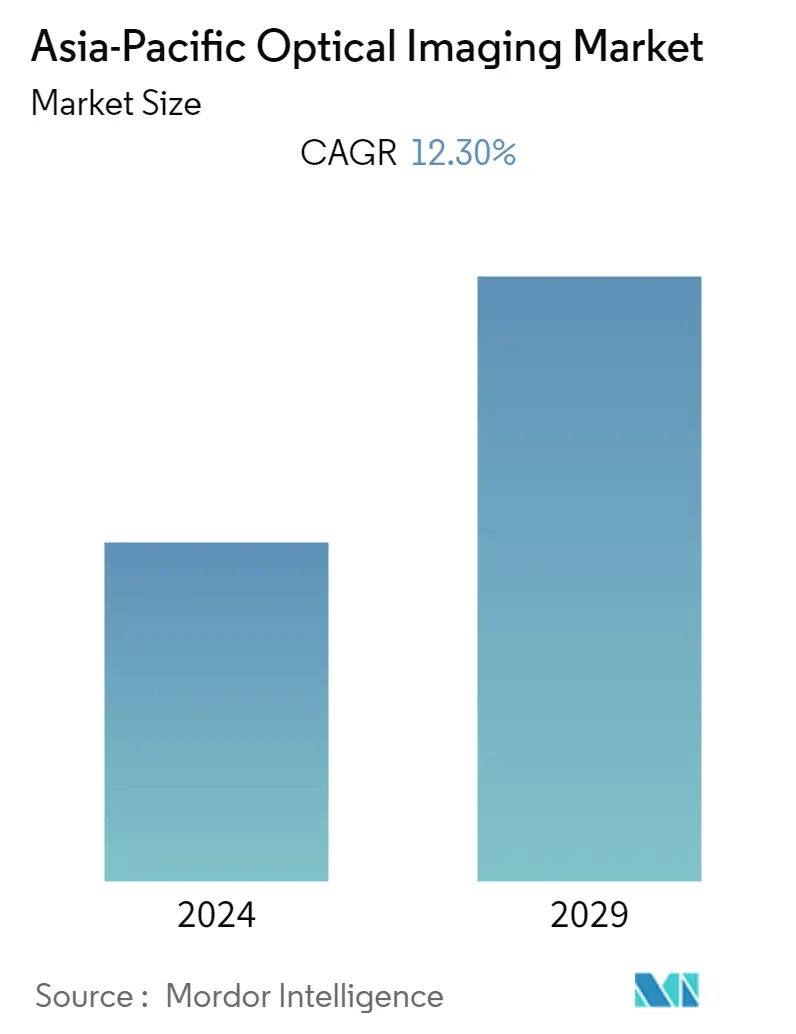Market Size of Asia-Pacific Optical Imaging Industry

| Study Period | 2019 - 2029 |
| Base Year For Estimation | 2023 |
| Forecast Data Period | 2024 - 2029 |
| Historical Data Period | 2019 - 2022 |
| CAGR | 12.30 % |
| Market Concentration | Medium |
Major Players
*Disclaimer: Major Players sorted in no particular order |
APAC Optical Imaging Market Analysis
The Asia-Pacific optical imaging market is expected to register a CAGR of 12.3% during the forecast period (2022 - 2027). The market is expected to grow due to increased demand for non-invasive procedures and non-ionizing imaging modalities, particularly among the elderly.
According to the World Health Organization (WHO), while the proportion of people aged 60 or above in Southeast Asia was 9.8% in 2017, it will increase to 13.7% and 20.3% by 2030 and by 2050, respectively. Further, according to the United Nations, in 2040, the forecasted percentage of the population of Singapore above the age of 65 will be more than 29%. Ionizing radiation, such as X-rays, can cause various health problems, including deterioration of cell functioning and oncogenic mutations. Optical imaging techniques use non-ionizing radiation to reduce the harmful effects of radiation, resulting in increased utilization in hospitals and clinics, driving market expansion.
The increased use of optical imaging modalities for therapeutic and diagnostic purposes like disease diagnosis, preclinical research, and discrete molecular and cellular process imaging is likely to boost the market growth.
Diffuse optical tomography (DOT) and imaging (DOI) are witnessing robust growth in the region. They are non-invasive procedures that evaluate tissue parameters such as total hemoglobin concentration and blood oxygen saturation using light in the near-infrared region. The techniques are frequently utilized for breast cancer imaging, functional brain imaging, stroke detection, photodynamic therapy, and radiation therapy monitoring because they perform effectively in soft tissue.
The region is also featuring an increasing trend of collaborations and partnerships between companies to leverage their technical capabilities and manufacturing infrastructure to innovate advanced products and processes to cater to the evolving and complex needs of the aging consumer base. For instance, OmniVision Technologies Inc., a manufacturer of advanced digital imaging solutions, and Diaspective Vision GmbH, a high-quality hyperspectral and multispectral camera systems developer for medical applications, teamed up in November 2021 to develop the Malyna system, an advanced endoscopic camera based on proprietary multispectral imaging technology. Malyna provides indocyanine green (ICG)-based perfusion imaging and serves as a framework for the adaptation of additional algorithms for measured perfusion and tissue categorization without using a color agent. The device combines physiological data with a 4K live video stream to provide surgeons with objective decision-making support.
However, high instrument costs, strict regulatory approval procedures, a scarcity of qualified operators, and inadequate reimbursements for optical imaging operations limit the market's growth. Several imaging and diagnostic departments have seen a quick drop in optical imaging case volumes as a result of COVID-19, owing to the increasing requirement for social distancing among patients, physicians, and other healthcare professionals.
APAC Optical Imaging Industry Segmentation
The Asia-Pacific optical imaging market is segmented by technology (photoacoustic tomography, optical coherence tomography, hyperspectral imaging, and near-infrared spectroscopy), product (imaging systems, illumination systems, lenses, and optical imaging software), application areas (ophthalmology, oncology, cardiology, dermatology, neurology, dentistry), end-user industry (hospitals and clinics, research and diagnostic laboratories, pharmaceutical industry, and biotechnology companies), and geography.
Optical imaging is a technique that utilizes light and photon properties to develop detailed images of organs, tissues, cells, and even molecules. The procedure provides non-invasive or slightly invasive ways to view within the body.
| Technology | |
| Photoacoustic Tomography | |
| Optical Coherence Tomography | |
| Hyperspectral Imaging | |
| Near-infrared Spectroscopy |
| Product | |
| Imaging Systems | |
| Illumination Systems | |
| Lenses | |
| Optical Imaging Software | |
| Other Products |
| Application Areas | |
| Ophthalmology | |
| Oncology | |
| Cardiology | |
| Dermatology | |
| Neurology | |
| Dentistry | |
| Other Application Areas |
| End-user Industry | |
| Hospitals and Clinics | |
| Research and Diagnostic Laboratories | |
| Pharmaceutical Industry | |
| Biotechnology Companies |
| Geography | |
| China | |
| India | |
| Japan | |
| Rest of Asia-Pacific |
Asia-Pacific Optical Imaging Market Size Summary
The Asia-Pacific optical imaging market is poised for significant growth, driven by the increasing demand for non-invasive and non-ionizing imaging techniques, particularly among the aging population. The region's demographic shift, with a rising proportion of elderly individuals, is fueling the adoption of optical imaging modalities in healthcare settings. These techniques, which include diffuse optical tomography and imaging, are gaining traction due to their effectiveness in soft tissue imaging and their application in various medical fields such as cancer detection and brain imaging. The market is also witnessing a surge in collaborations and partnerships among companies aiming to innovate and develop advanced optical imaging products, catering to the complex needs of the aging consumer base.
Despite the promising growth prospects, the market faces challenges such as high instrument costs, stringent regulatory approval processes, and a shortage of qualified operators. The COVID-19 pandemic has further impacted the market by reducing optical imaging case volumes due to social distancing measures. However, advancements in optical instruments and contrast agents are enhancing the sensitivity and specificity of cancer detection, thereby driving market expansion. The ophthalmology sector in the region is also contributing to market growth, with the increasing use of optical coherence tomography and the integration of artificial intelligence in diagnostic techniques. Key players in the market are leveraging their technological capabilities to innovate and capture a broader geographic area, ensuring a competitive landscape.
Asia-Pacific Optical Imaging Market Size - Table of Contents
-
1. MARKET INSIGHTS
-
1.1 Market Overview
-
1.2 Industry Attractiveness - Porter's Five Forces Analysis
-
1.2.1 Threat of New Entrants
-
1.2.2 Bargaining Power of Buyers
-
1.2.3 Bargaining Power of Suppliers
-
1.2.4 Threat of Substitute Products
-
1.2.5 Intensity of Competitive Rivalry
-
-
1.3 Technology Snapshot
-
-
2. MARKET SEGMENTATION
-
2.1 Technology
-
2.1.1 Photoacoustic Tomography
-
2.1.2 Optical Coherence Tomography
-
2.1.3 Hyperspectral Imaging
-
2.1.4 Near-infrared Spectroscopy
-
-
2.2 Product
-
2.2.1 Imaging Systems
-
2.2.2 Illumination Systems
-
2.2.3 Lenses
-
2.2.4 Optical Imaging Software
-
2.2.5 Other Products
-
-
2.3 Application Areas
-
2.3.1 Ophthalmology
-
2.3.2 Oncology
-
2.3.3 Cardiology
-
2.3.4 Dermatology
-
2.3.5 Neurology
-
2.3.6 Dentistry
-
2.3.7 Other Application Areas
-
-
2.4 End-user Industry
-
2.4.1 Hospitals and Clinics
-
2.4.2 Research and Diagnostic Laboratories
-
2.4.3 Pharmaceutical Industry
-
2.4.4 Biotechnology Companies
-
-
2.5 Geography
-
2.5.1 China
-
2.5.2 India
-
2.5.3 Japan
-
2.5.4 Rest of Asia-Pacific
-
-
Asia-Pacific Optical Imaging Market Size FAQs
What is the current Asia-Pacific Optical Imaging Market size?
The Asia-Pacific Optical Imaging Market is projected to register a CAGR of 12.30% during the forecast period (2024-2029)
Who are the key players in Asia-Pacific Optical Imaging Market?
Bruker Corporation, Leica Microsystems, Topcon Corporation, Olympus Corporation and CytoViva, Inc. are the major companies operating in the Asia-Pacific Optical Imaging Market.

